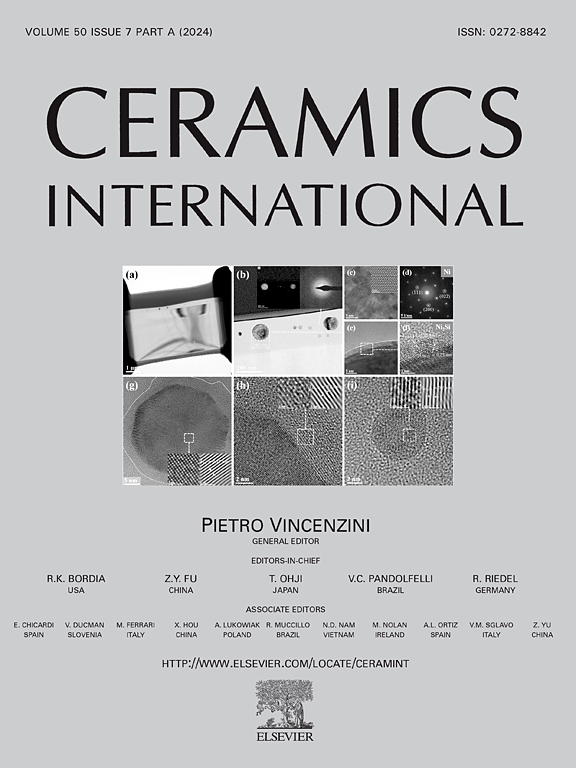Stoichiometry of CoFe2O4 as a key to phase control and improved functional properties of multiferroic BaTiO3-CoFe2O4 bulk composites
IF 5.6
2区 材料科学
Q1 MATERIALS SCIENCE, CERAMICS
引用次数: 0
Abstract
Composite multiferroics have been widely studied as materials with large magnetoelectric effect at room temperature. They have also been envisaged as materials exhibiting multicaloric effects. Although the best magnetoelectric coupling has been achieved in multiferroic bilayer thin films with 2-2-connectivity, multicaloric applications require bulk ceramic composites with large thermal mass, high density, and low resistivity. Unfortunately, high temperature sintering of multiferroic ceramics often results in the formation of secondary phases and undesirable chemical modifications of the constituents, which are detrimental to the functional properties. Thus, for the “canonical” multiferroic composites of ferroelectric BaTiO3 and ferrimagnetic CoFe2O4, the formation of a secondary phase of barium hexaferrite, BaFe12O19, has been frequently observed, but not always explicitly reported. In this article, we present a method to suppress the formation of this phase both by sintering in nitrogen and by changing the stoichiometry of cobalt ferrite to incorporate more cobalt. The latter restricts the diffusion of the iron cations into barium titanate during sintering which is the main driving force for the formation of BaFe12O19. Moreover, composites with non-stoichiometric Co1.05Fe1.95O4 show a three-fold improvement in magnetoelectric coefficient in comparison to composites with stoichiometric cobalt ferrite.
CoFe2O4的化学计量学是多铁BaTiO3-CoFe2O4块体复合材料相控制和功能性能改善的关键
复合多铁材料作为一种在室温下具有较大磁电效应的材料而得到了广泛的研究。它们也被设想为具有多色效应的材料。虽然在具有2-2连接的多铁双层薄膜中已经实现了最佳的磁电耦合,但多色应用需要具有大热质量、高密度和低电阻率的大块陶瓷复合材料。然而,多铁陶瓷的高温烧结往往会导致二次相的形成和组分的不良化学修饰,这对其功能性能是不利的。因此,对于铁电性BaTiO3和铁磁性CoFe2O4的“典型”多铁复合材料,六铁体钡的二次相BaFe12O19的形成已经被经常观察到,但并不总是明确报道。在本文中,我们提出了一种抑制该相形成的方法,既可以在氮气中烧结,也可以通过改变钴铁氧体的化学计量来加入更多的钴。后者限制了钛酸钡烧结过程中铁离子向钛酸钡的扩散,而钛酸钡是BaFe12O19形成的主要驱动力。此外,非化学计量Co1.05Fe1.95O4的复合材料的磁电系数比化学计量钴铁氧体的复合材料提高了3倍。
本文章由计算机程序翻译,如有差异,请以英文原文为准。
求助全文
约1分钟内获得全文
求助全文
来源期刊

Ceramics International
工程技术-材料科学:硅酸盐
CiteScore
9.40
自引率
15.40%
发文量
4558
审稿时长
25 days
期刊介绍:
Ceramics International covers the science of advanced ceramic materials. The journal encourages contributions that demonstrate how an understanding of the basic chemical and physical phenomena may direct materials design and stimulate ideas for new or improved processing techniques, in order to obtain materials with desired structural features and properties.
Ceramics International covers oxide and non-oxide ceramics, functional glasses, glass ceramics, amorphous inorganic non-metallic materials (and their combinations with metal and organic materials), in the form of particulates, dense or porous bodies, thin/thick films and laminated, graded and composite structures. Process related topics such as ceramic-ceramic joints or joining ceramics with dissimilar materials, as well as surface finishing and conditioning are also covered. Besides traditional processing techniques, manufacturing routes of interest include innovative procedures benefiting from externally applied stresses, electromagnetic fields and energetic beams, as well as top-down and self-assembly nanotechnology approaches. In addition, the journal welcomes submissions on bio-inspired and bio-enabled materials designs, experimentally validated multi scale modelling and simulation for materials design, and the use of the most advanced chemical and physical characterization techniques of structure, properties and behaviour.
Technologically relevant low-dimensional systems are a particular focus of Ceramics International. These include 0, 1 and 2-D nanomaterials (also covering CNTs, graphene and related materials, and diamond-like carbons), their nanocomposites, as well as nano-hybrids and hierarchical multifunctional nanostructures that might integrate molecular, biological and electronic components.
 求助内容:
求助内容: 应助结果提醒方式:
应助结果提醒方式:


